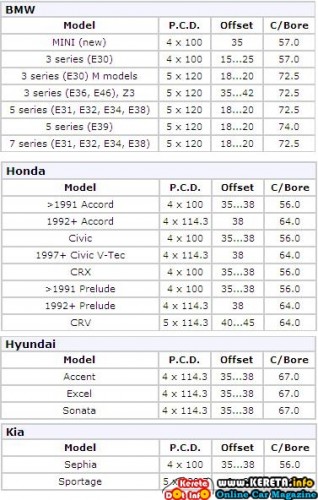PCD–Pitch Circle Diameter
 Many people are confused with those definition. PCD, OFFSET and CENTERBORE is totally important thing or definition when you are going to buy a new sport rims. Here is some explanation about it and some guide to choose a sport rims that suitable for your car.
Many people are confused with those definition. PCD, OFFSET and CENTERBORE is totally important thing or definition when you are going to buy a new sport rims. Here is some explanation about it and some guide to choose a sport rims that suitable for your car.WHAT IS PCD?

The meaning of PCD? PCD stands for pitch circle diameter and is the diameter of a circle drawn through the centre of your wheel’s bolt holes. ]
P.C.D. is measured in millimeters and also indicate the number of studs or bolts the wheel will have. Proton Alloy Wheels are usually either 4×100: i.e. 4 bolt holes drilled through the centre of an imaginary 100mm circle.
About the holes & bolts attached, most Proton & Perodua Cars have 4 bolts, most U.S. passenger cars have 5 bolts while compact models sometimes have only 4 and pick-up trucks can have as many as 6 or 8. In contrast, some smaller French cars, including the Citroën 2CV, Renault 4 and some Peugeot 106′s and Citroen Saxos only have three which is same with Proton Tiara.

RIM PCD OFFSET AND CENTERBORE OF MAZDA, NISSAN & TOYOTA (picture above)
If you can see the schedule above shows some PCD of cars. The vehicle with more holes like Land Cruiser is because of the SUV needs more strength to hold the rims.
Some aftermarket rim manufacturers do provide universal-fit rims which have elongated lug holes (or 8-10 holes which cover multiple bolt patterns) which will fit a wider-range of vehicles.
The most common PCD values are 100 mm and 114.3 mm. This difference arises from the manufacturers’ measurement convention – whether they are designing around metric values (100 mm) or imperial values (4.5 inches, i.e. 114.3 mm).

RIM PCD OFFSET AND CENTERBORE OF BMW, HONDA, HYUNDAI, KIA(picture above)
WHAT IS RIM OFFSET?
The offset, measured in millimeters, can be negative or positive, and is the distance from the hub-mounting surface to the rim’s true centerline. A positive offset means the hub-mounting surface is closer to the outside edge of the wheel, i.e. the wheel wraps around the hub and brake hardware more deeply; a negative offset means the hub-mounting surface is closer to the inside edge of the wheel and wheel sticks outwards more than inwards.
Negative Offset wheels have their mounting face toward the rear of the wheel – powerful rear-wheel drive cars often have wheels with negative offset. This is the contributing factors of being a bigger “lips” rim.
When selecting aftermarket wheels, a wheel with too little positive offset will be closer to the fender, and one with too much positive offset will be closer to the suspension components. Wheel width, offset and tire size all determine the way a particular wheel/tire combination will work on a given car.
To maintain handling characteristics and avoid undue loads on bushings and ball joints, the car manufacturer’s original offset should be maintained when choosing new wheels unless there are overriding clearance issues.

Offset also affects the scrub radius of the steering and it is advisable to stay within the limits allowed by the vehicle manufacturer. Because wheel offset changes the lever-arm length between the center of the tire and the centerline of the steering knuckle, the way bumps, road imperfections and acceleration and braking forces are translated to steering torques (bump-steer, torque-steer, etc) will change depending on wheel offset. Likewise, the wheel bearings will see increased thrust loads if the wheel centerline is moved away from the bearing centerline.
WHAT IS CENTERBORE?
The center bore of an alloy wheel is the size of the hole at the back of the wheel which the hub fits into. To help the wheels to seat properly this hole needs to be an exact match to the size of the hub. Please refer to the first picture above this articles.
Some factory wheels have a centerbore that matches exactly with the hub to reduce vibration by keeping the wheel centered. Wheels with the correct centerbore to the car they will be mounted on are known as hubcentric. Hubcentric wheels take the stress off the lug nuts, reducing the job of the lug nuts to center the wheel to the car.
Wheels that are not hubcentric are known as lugcentric, as the job of centering is done by the lug nuts assuming they are properly torqued down. Centerbore on aftermarket wheels must be equal to or greater than that of the hub or the wheel cannot be mounted on the car. Many aftermarket wheels come with “hubcentric rings” that lock or slide into the back of the wheel to adapt a wheel with a larger centerbore to a smaller hub. These adapters are usually made of plastic but also in aluminium.


Comments
Post a Comment